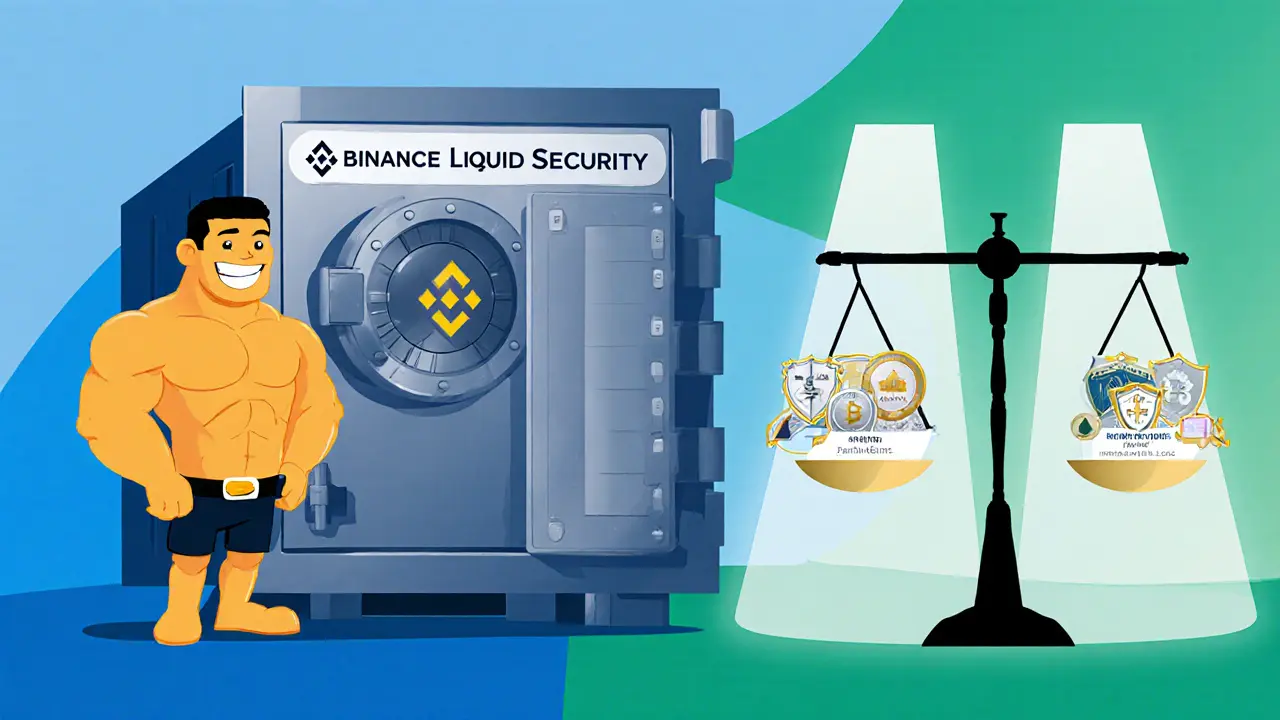
- 14 Oct 2024
- Elara Crowthorne
- 13
Binance Liquid Swap Fee Calculator
Fee Breakdown
Binance Liquid Swap
Flat 0.10% fee
No gas fees
Uniswap V3
0.30% fee + Gas fees
Variable gas costs
SushiSwap
0.25% fee + Gas fees
Chain-dependent gas
When it comes to swapping tokens without the hassle of order books, Binance Liquid Swap is an automated market‑maker (AMM) service built into the Binance ecosystem that lets users trade and provide liquidity in paired pools. The platform blends decentralized finance mechanics with Binance’s centralized security, offering a middle ground between pure DEXes like Uniswap and traditional spot markets. In this review we’ll break down how the service works, its fee structure, safety measures, liquidity incentives, and who stands to benefit the most.
How Binance Liquid Swap Operates
The core of the service is the Automated Market Maker (AMM) algorithm that balances token prices based on the ratio of assets in a liquidity pool. Each pool holds two tokens-e.g., BNB/USDT-so when a trader swaps one for the other, the pool’s composition shifts, automatically adjusting the price. This design eliminates the need for a traditional order book and keeps slippage low for large orders.
Liquidity providers (LPs) deposit equal‑value amounts of both tokens into a pool. In return they earn a slice of the transaction fees generated by swaps in that pool. The reward system mirrors other AMMs, but Binance’s high trading volume means fee income can be noticeably larger than on smaller DEXes.
Fees, Slippage & Cost Efficiency
Binance undercuts many competitors by charging a flat trading fee of 0.10% for swaps. By contrast, major centralized exchanges often list fees around 0.20% and some DEXes impose higher gas costs on busy networks. Because the AMM runs on Binance’s internal infrastructure, users avoid most blockchain gas fees when swapping directly from their Binance wallet.
Slippage-the price impact of a trade-remains minimal thanks to deep liquidity. The platform’s pricing formula reacts instantly to pool imbalances, meaning a $50,000 order can be executed with less than 0.2% slippage on popular pairs. For traders handling large volumes, this can translate into substantial cost savings.
Security, Custody & Regulatory Landscape
One of the biggest differentiators is the centralized custody model. Binance holds 100% of client assets in cold storage and maintains licenses from 18 regulators worldwide. This infrastructure provides a layer of protection that pure DEXes simply cannot match, as there is no reliance on user‑controlled private keys for the swap itself.
Since the November2023 settlement with regulators, Binance has tightened compliance, implementing rigorous KYC/AML procedures and publishing regular proof‑of‑reserve audits using Merkle trees and zk‑SNARKs. While the platform is not entirely “decentralized,” the added oversight reduces the risk of hacks that have plagued many blockchain‑only DEXes.
Liquidity Provision, Rewards & Impermanent Loss
When you become an LP, you earn a portion of the 0.10% swap fee proportional to your share of the pool. For high‑traffic pairs like BNB/USDT, annualized returns can hover between 12%-18% before fees and gas are considered. Binance also runs occasional “Liquidity Mining” campaigns that boost rewards with native tokens.
However, LPs must understand impermanent loss the temporary reduction in value that occurs when the relative price of the pooled assets diverges. During volatile market swings, the value of your pooled tokens can fall below the amount you’d have if you simply held them, a risk that no platform can fully eliminate.
Comparison with Leading AMMs
| Feature | Binance Liquid Swap | Uniswap (V3) | SushiSwap |
|---|---|---|---|
| Underlying Architecture | Centralized AMM on Binance’s infrastructure | Fully decentralized on Ethereum | Fully decentralized on multiple chains |
| Typical Trading Fee | 0.10% (flat) | 0.30% (plus gas) | 0.25% (plus gas) |
| Liquidity Depth | High (benefits from Binance’s 24‑hr volume > $2B) | Medium‑high, varies by pool | Medium, varies by chain |
| Security Model | Custodial, regulated, cold‑storage | Non‑custodial, smart‑contract risk | Non‑custodial, smart‑contract risk |
| Supported Assets | Dozens of major pairs (limited vs Binance Spot) | Hundreds of ERC‑20 tokens | Hundreds across multiple chains |
| User Experience | Integrated with Binance UI, no external wallet needed | Requires Web3 wallet connection | Requires Web3 wallet connection |
User Onboarding & Everyday Use
Getting started is straightforward: you need a verified Binance account, log in, and navigate to the “Liquid Swap” tab. No separate wallet connections or smart‑contract approvals are necessary, which lowers the entry barrier for newcomers. The UI mirrors the familiar spot‑trading layout-select a pair, input the amount, review the price impact, and confirm.
Binance also provides in‑app educational pop‑ups that outline risks such as impermanent loss and price volatility. Support is handled through Binance’s existing ticket system, and the platform’s documentation, hosted on Binance Academy, offers step‑by‑step guides with screenshots.

Pros, Cons & Ideal Users
Here’s a quick rundown of the strengths and weaknesses:
- Pros
- Low, flat trading fee of 0.10%
- Deep liquidity reduces slippage on large orders
- Custodial security backed by regulatory licenses
- Seamless integration with Binance’s broader ecosystem (Spot, Futures, Earn)
- Simple onboarding-no external wallet required
- Cons
- Limited asset selection compared to Binance Spot or fully open DEXes
- Centralized custody means users can’t retain full control of private keys
- Impermanent loss risk remains for LPs during volatile markets
- Regulatory scrutiny could affect future feature rollouts
If you value security, low fees, and a frictionless experience, Binance Liquid Swap is a solid choice. Advanced DeFi users who crave full decentralization may still prefer pure DEXes, but for most retail traders and newcomers, it hits the sweet spot between convenience and cost.
Frequently Asked Questions
Frequently Asked Questions
Is Binance Liquid Swap truly decentralized?
No. It runs on Binance’s centralized infrastructure, which provides custodial security and regulatory compliance, but it does not give users control of private keys for the swap itself.
What fees do I pay when swapping tokens?
A flat 0.10% fee is applied to every swap. There are no additional platform fees, though you still pay the underlying blockchain’s network fee when withdrawing assets.
How can I earn from providing liquidity?
Liquidity providers receive a share of the 0.10% swap fee proportional to their pool share. Binance occasionally adds extra token incentives during promotional liquidity‑mining campaigns.
What is impermanent loss and how does it affect me?
Impermanent loss occurs when the price ratio of the two tokens in a pool changes after you deposit. The loss is "impermanent" because it can be recovered if prices converge, but it can become permanent if you withdraw while the disparity remains.
Do I need an external wallet to use Liquid Swap?
No. All operations happen inside your Binance account, so you never have to connect a separate Web3 wallet.


13 Comments
Binance’s Liquid Swap is a solid entry point for folks who want low‑fee swaps without the hassle of external wallets. The flat 0.10% charge really shines when you’re moving thousands of dollars, keeping slippage in check. Because the platform is custodial, you benefit from Binance’s insurance and compliance layers. Just remember that you’re handing over private key control, so weigh that against the convenience. For new traders, the UI feels like spot‑trading, making the learning curve gentle. Overall, it’s a pragmatic bridge between centralized exchanges and pure DeFi.
The Binance Liquid Swap model, when examined through the lens of fee structures, reveals a compelling case for traders who prioritize cost efficiency above all else, especially when juxtaposed with decentralized counterparts that impose both protocol and gas fees. A flat 0.10% fee, applied uniformly across all supported pairs, eliminates the uncertainty inherent in variable fee models and simplifies budgeting for large‑scale transactions. Moreover, the absence of additional platform fees means that the total cost basis for a swap is transparent, which can be a decisive factor for institutional participants accustomed to rigorous accounting standards. Liquidity depth further amplifies this advantage, as deep order books mitigate price impact, allowing sizable orders to be executed with minimal slippage. The custodial nature of the service, while raising questions about key sovereignty, also brings the benefit of regulated security measures, cold‑storage reserves, and compliance oversight that many DeFi protocols simply cannot guarantee. For users who are risk‑averse or operate within jurisdictions demanding stringent KYC/AML protocols, this added layer of institutional backing provides a sense of reassurance that is often absent in the trustless paradigm. Additionally, integration with Binance’s broader ecosystem-spot trading, futures, and earn products-creates a seamless workflow where assets can be moved between services without leaving the platform. This interoperability reduces transaction friction, effectively lowering the opportunity cost associated with moving funds across disparate networks. While the asset roster is narrower than what is offered on expansive DEX aggregators, the most liquid and widely traded pairs are well‑represented, ensuring that the majority of retail traders find their preferred markets. The platform’s educational pop‑ups and in‑app guides further lower the entry barrier, demystifying concepts such as impermanent loss and price impact for newcomers. It is also worth noting that Binance periodically runs liquidity mining incentives, sprinkling additional token rewards on top of the base swap fees, which can enhance yields for liquidity providers. From a compliance perspective, the centralized custody model aligns with evolving regulatory frameworks, potentially shielding users from abrupt protocol shutdowns or legal entanglements that have plagued some DeFi projects. In contrast, decentralized swaps remain vulnerable to code exploits, governance attacks, and sudden token de‑listings, all of which can erode user confidence. Therefore, for a trader whose primary objectives are low fees, robust security, and a frictionless user experience, Binance Liquid Swap emerges as a highly attractive option. Conversely, power users seeking full decentralization, custom token pairs, or on‑chain provenance may find the platform’s constraints limiting. In sum, the service occupies a pragmatic middle ground, delivering cost‑effective swaps while retaining the safety net of a regulated exchange, a balance that resonates strongly with the current market demand for both efficiency and security.
If you don’t read the fine print you’re basically handing over your money to the man.
Great breakdown! Your explanation really shines a light on why the flat fee can be a game‑changer, especially for folks juggling multiple strategies. I love how you highlighted the educational pop‑ups-they’re like friendly signposts guiding newbies through the murky waters of DeFi. The way you balanced security concerns with convenience makes the whole picture feel balanced and approachable. Keep the insightful posts coming; they’re a bright spot in a sea of jargon.
While the glossy presentation paints a rosy picture, it’s crucial to remember that Binance, like any centralized entity, sits atop a massive data collection infrastructure that could be leveraged for market manipulation, especially when combined with hidden algorithmic trade matching engines. The “regulated” label often masks a web of offshore subsidiaries, each operating under different jurisdictional oversight, which can create loopholes for regulatory arbitrage. Moreover, the custodial model means your assets are essentially pooled in a single vault, making it a tempting target for nation‑state actors looking to disrupt the crypto ecosystem. Even the occasional “security audit” might not capture insider threats or zero‑day exploits hidden deep within proprietary code. So, while the fee is low, the systemic risk exposure may be significantly higher than any DEX that distributes risk across many nodes. It’s worth staying vigilant and not letting the low fee seduce you into complacency.
Wow, Don, you just turned a simple fee review into a full‑blown thriller! 🎭 But seriously, the drama over “hidden algorithms” is overblown-most users just want cheap swaps, not conspiracy theories. Binance has survived countless hacks and still stands, so maybe the risk isn’t as apocalyptic as you paint.
Indeed, the situation, while complex, does not necessarily warrant alarm; however, a measured approach, incorporating both fee considerations and risk assessments, is advisable, especially for large‑scale participants.
Love how Binance keeps the fees low – makes swapping a breeze! 🚀💸
Exactly, the cheap fee means I can move my money without worrying about extra costs. The UI is also easy to understand, so I can trade quickly.
When we consider the trade‑off between decentralization and usability, Binance Liquid Swap illustrates a classic tension: the desire for autonomy versus the need for convenience. In a world where financial sovereignty is prized, the platform offers a pragmatic compromise that many users find acceptable.
Exactly!! The compromise is real-no one wants to be bogged down by endless gas fees, and Binance delivers a clean, fast experience!!!
Honestly, the liquid swap is a total game changer – I mean, who wants to pay 0.30% on Uniswap when you can get 0.10% on Binance? It’s like comparing a Ferrari to a tricycle, no kidding!
I see your point about the fee difference; the lower cost definitely makes Binance attractive for frequent traders.